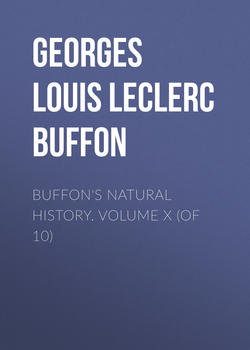Buffon's Natural History. Volume X (of 10)

Реклама. ООО «ЛитРес», ИНН: 7719571260.
Оглавление
Comte de Buffon Georges Louis Leclerc. Buffon's Natural History. Volume X (of 10)
OF THE DEGENERATION OF ANIMALS
AND PROPERTIES OF MINERALS, VEGETABLES, &c. LIGHT, HEAT, AND FIRE
OF AIR, WATER, AND EARTH
EXPERIMENTS ON THE PROGRESS OF HEAT IN MINERAL SUBSTANCES
A TABLE. OF THE. Relations of different Mineral Substances
OBSERVATIONS ON THE NATURE OF PLATINA
EXPERIMENTS ON LIGHT, AND ON THE HEAT IT MAY PRODUCE
OBSERVATIONS AND EXPERIMENTS ON TREES AND OTHER VEGETABLES
ON THE TEMPERATURE OF THE PLANETS
GENERAL VIEWS OF NATURE
SECOND VIEW
Отрывок из книги
ALL the powers of Nature with which we are acquainted, may be reduced to two primitive forces; the one which causes weight, and that which produces heat. The force of impulsion is subordinate to them; it depends on the first for its particular, and on the latter for its general effects. As impulsion cannot exercise itself but by the means of a spring, and the spring only acts by virtue of the force which approximates the remote parts, it is clear, that to perform its power it has need of the concurrence of attraction: for if matter ceased to attract, if bodies lost their coherence, every spring would be destroyed, every motion intercepted, and every impulsion void; since motion cannot transmit itself from one body to another but by elasticity, it is demonstrable, that one body absolutely hard and inflexible, would be absolutely immoveable, and entirely incapable of receiving the action of another. Attraction being a general and permanent effect, impulsion, which in most bodies is neither constant nor fixed, depends on it as a particular effect; for, if all impulsion were destroyed, attraction would still equally subsist and act; it is, therefore, this essential difference which makes impulsion subordinate to attraction in all inanimate and purely passive matter.
But this impulsion depends still more immediately, and generally, on the power which produces heat; for it is principally by the means of heat, that impulsion penetrates organized bodies; it is by heat that they are formed, grow, and develope themselves. We may refer to attraction alone all the effects of inanimate matter; and in this same power of attraction, joined to that of heat, every phenomena of live matter. By live matter I understand not only every thing that lives, or vegetates, but also every living organic molecule, dispersed in the waste or remains of organized bodies. In it I comprehend also light, heat, fire, and all matter which appears to be active in itself. Now this live matter always tends from the centre to the circumference, whereas brute or inanimate matter tends from the circumference to the centre. It is an expansive power which animates the live matter, and it is an attractive force to which the inanimate matter is obedient. Although the directions of these two powers be diametrically opposite, yet they balance themselves without ever being destroyed, and from the combination of these two powers equally active, all the phenomena of the universe result.
.....
Fire, which at first sight appears to be only a compound of heat and light, might also be a modification of the matter, though it does not essentially differ from either, and still less from both taken together. Fire never exists without heat, but it can exist without light. Heat alone, deprived of all appearance of light, can produce the same effects as the most violent fire; so can also light, when it is united. Light seems to carry a substance in itself which has no need of fuel; but fire cannot subsist without absorbing the air, and it becomes more violent in proportion to the quantity it absorbs; whereas light, concentrated and received into a vessel exhausted of air, acts as fire in air; and heat, confined and retained in a narrow space, subsists and even augments with a very small quantity of food. The most general difference between fire, heat, and light, appears, therefore, to consist in the quantity, and perhaps quality, of their food.
Air is the first food of fire; combustible matters are only the second. It has been demonstrated, by experiments, that a little spark of fire, placed in a vessel well closed, in a short time absorbs a great quantity of air, and becomes extinguished as soon as the quantity or quality, of this food becomes deficient. By other experiments it is proved, that the most combustible matters will not consume in vessels well closed, although exposed to the action of the greatest fire. Air is, therefore, the first and true food of fire, and combustible matters would not be able to supply it without the assistance and mediation of this element.
.....